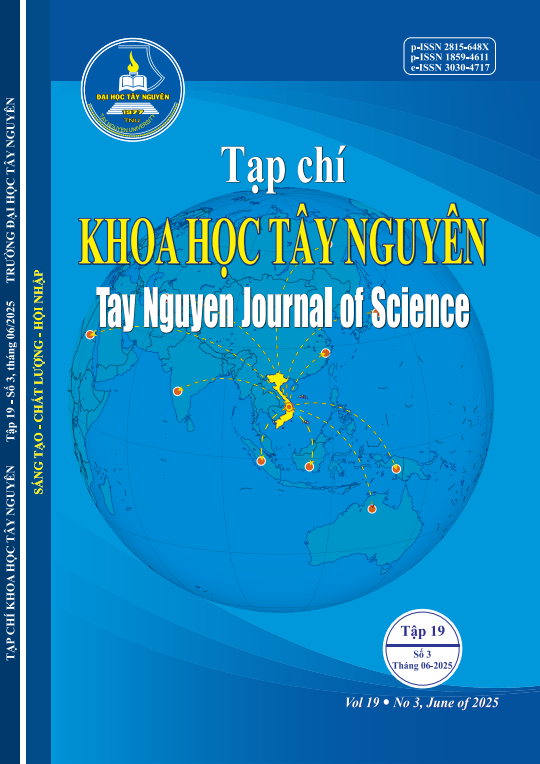Tình hình nhiễm sán dây Moniezia spp ở đường tiêu hóa của dê thịt nuôi trong nông hộ trên địa bàn huyện Chư Pưh, tỉnh Gia Lai
Main Article Content
Tình hình nhiễm sán dây Moniezia spp ở đường tiêu hóa của dê thịt nuôi trong nông hộ trên địa bàn huyện Chư Pưh, tỉnh Gia Lai
Tóm tắt
Trong nghiên cứu này, chúng tôi tiến hành xét nghiệm 287 mẫu phân dê thịt nuôi trong nông hộ tại 3 xã trên địa bàn huyện Chư Pưh tỉnh Gia Lai bằng phương pháp Fulleborn nhằm xác định tỷ lệ nhiễm sán dây đường tiêu hóa trên dê. Kết quả cho thấy có 69/287 mẫu phân nhiễm sán dây, chiếm tỷ lệ 24,04%. Trong 3 xã, Ia Hla có tỷ lệ nhiễm cao nhất (29,59%) và tỷ lệ nhiễm thấp nhất ở Chư Don (19,35%). Dê nuôi theo phương thức bán chăn thả có tỷ lệ nhiễm 31,07% cao hơn phương thức nuôi nhốt 20,11% (P<0,05). Vào mùa mưa, tỷ lệ nhiễm sán dây đường tiêu hóa của dê là 28,99% cao hơn phương thức nuôi nhốt 16,95%. Tỷ lệ nhiễm sán dây giảm dần theo lứa tuổi: dê ở độ tuổi < 1 năm tuổi, 1-2 năm tuổi và > 2 năm tuổi có tỷ lệ nhiễm giun tròn lần lượt là 36,05%; 23,91% và 7,94%. Thử nghiệm tẩy trừ sán dây trên dê bằng 2 loại thuốc Niclosamid (uống) với liều 20mg/kg TT và Praziquantel (uống) với liều 15mg/kg TT cho hiệu quả tẩy trừ sán dây trên dê là 100%. Hai loại thuốc này đều an toàn trên dê, không gây phản ứng phụ trong suốt quá trình thử nghiệm.
Article Details

Tác phẩm này được cấp phép theo Giấy phép quốc tế Creative Commons Attribution-NonCommercial-NoDeri Phái sinh 4.0 .
Tài liệu tham khảo
- Chikweto A., Tiwari K., Bhaiyat M. I., Carloni J., Pashaian K., Pashaian A., Allie C. D. and Sharma R. N. (2018). “Gastrointestinal parasites in small ruminants from Grenada, West Indies: A coprological survey and a review of necropsy cases”, Veterinary Parasitology: Regional Studies and Reports, 13, pp. 130 - 134.
- Dixit A. K., Das G., Baghel R. P. S. (2017). “Gastrointestinal elminthosis: prevalence and associated determinants in goats of Jabalpur, India”, Journal of Parasitic Diseases, 41(2), pp. 414 - 416.
- El-Shahawy I.S. (2016). Coproscopic study on enteric protozoan parasites of goats (Capra hircus L., 1758) in Upper Egypt, Pakist J. Zoo., 48(5): 1477-83.
- Faran N.K., Sanweer K., Deepak K.S., Subha G. And Vikas K. (2017). Studies on prevalence of helminth infection in goats in Udaipur district (Rajasthan), J. Ent. Zoo. Stu., 5(6): 2002-06.
- Ghimire T.R. and Bhattarai N. (2019). A survey of gastrointestinal parasites of goats in a goat market in Kathmandu, Nepal, J. Par. Dis., 43(4): 686-95.
- Hashim N. and Yusof A.M. (2016). Rearing systems related to gastrointestinal parasites in goats from selected area in Terengganu, J. Tek., 78(10): 133-36.
- Jena A., Deb A.R., Kumari L., Biswal S.S. and Joshi S.K. (2018). Prevalence of gastrointestinal helminthes among goats in and around Ranchi, Jharkhand, India, Int. J. Cur. Mic. App. Sci., 7(1): 3506-13.
- Jittapalapong G., Saengow S., Pinyopanuwat N., Chimnoi W., Khachaeram W. and Stich R.W. (2012). Gastrointestinal Helminthic and Protozoal Infections of Goats in Satun, Thailand, J. Tro. Med. Par., 35: 48-54.
- Kelemework S., Tilahun A., Benalfew E. and Getachew A. (2016). “A study on prevalence of gastrointestinal helminthiasis of sheep and goats in and around Dire Dawa, Eastern Ethiopia”,
- Academic Journals, 8 (10), pp. 107 - 113.
- Mpofu T.J., Nephawe K.A. and Mtileni B. (2020). Prevalence of gastrointestinal parasites in communal goats from different agro-ecological zones of South Africa, Vet. World, 13(1): 26-32.
- Pathak A.K. and Pal S. (2008). Seasonal Prevalence of Gastrointestinal Parasites in Goats from Durg District of Chhattisgarh Vet. World, 1(5): 136-37.
- Raza M. A., Iqbal Z., Jabbar A., Yaseen M. (2007). “Point prevalence of gastrointestinal helminthiasis in ruminants in southern Punjab, Pakistan”, Journal Helminthol, 81 (3), pp. 323 - 328.
- Saiyam R., Das G., Verma R. and Kumar S. (2018). “Seasonal prevalence of caprine gastrointestinal helminths in central Madhya Pradesh”, Journal of Entomology and Zoology Studies, 6 (4), pp. 979 - 982.
- Saraf S. (2019). Studies on prevalence of anaplocephalidean cestode parasites of goat in paithan district aurangabad” Paripex – Ind. J. Res., 8(11): 19-20.
- Singh A.K., Das G., Roy B., Nath S., Naresh R. and Kumar S. (2015). Prevalence of gastro-intestinal parasitic infections in goat of Madhya Pradesh, India, J. Par. Dis., 39(4): 716-19.
- Trần Thị Tâm, Nguyễn Thị Kim Lan, Phan Thị Hồng Phúc, Nguyễn Thị Chinh, Nguyễn Thị Xuân Hồng, Đặng Hồng Quyên, Nguyễn Văn Lư, Nguyễn Việt Dũng (2022). Một số đặc điểm dịch tễ bệnh sán dây ở dê tại tỉnh Bắc Giang. Tạp chí KHKT Chăn nuôi. Tr. 84-91.
- Verma R., Sharma D.K., Paul S., Gururaj K., Dige M., Saxena V.K., Rout P.K., Bhusan S. and Banerjee P.S. (2018). Epidemiology of Common Gastrointestinal Parasitic Infections in Goats reared in SemiArid Region of India, J. Anim. Res., 8(1): 39-45.



